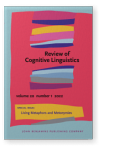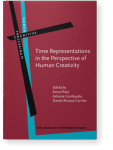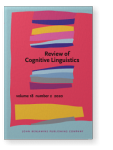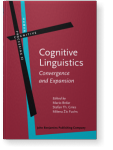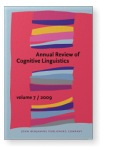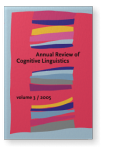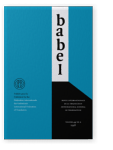Javier Valenzuela
List of John Benjamins publications for which Javier Valenzuela plays a role.
Journal
2022 The size of shame and pride: Testing metonymy in the figurative representation of moral emotions Living Metaphors and Metonymies, Brdar, Mario and Rita Brdar-Szabó (eds.), pp. 210–230 | Article
We investigate the figurative size (big or small) that more naturally fits the conceptual representation of the moral emotion concepts pride and shame. We hypothesize the pairings pride-big and shame-small to be more natural than their counterparts, because of the emotions’ expressive profile:… read more
2022 Chapter 1. A corpus-based look at time metaphors Time Representations in the Perspective of Human Creativity, Piata, Anna, Adriana Gordejuela and Daniel Alcaraz Carrión (eds.), pp. 15–40 | Chapter
Motion-based metaphors of time have been thoroughly discussed in the literature, but some aspects still remain underexplored. The present chapter addresses one of these areas, namely, the lexical richness of the motion verbs found in temporal expressions. We present the findings of a corpus… read more
2020 Gesturing in the wild: Evidence for a flexible mental timeline Review of Cognitive Linguistics 18:2, pp. 289–315 | Article
Psycholinguistic evidence shows that spatial domains are automatically activated when processing temporal expressions. Speakers conceptualize time as a straight line deployed along different axes (mostly sagittal, though also vertical). The use of the lateral axis, which cannot be lexicalized in… read more
2016 Why are embodied experiments relevant to cognitive linguistics? Computational Construction Grammar and Constructional Change, Beuls, Katrien and Remi van Trijp (eds.), pp. 265–286 | Article
Computational simulation models of cognitive linguistics are relatively scarce (cf Valenzuela, 2010). This is due, among other things, to the inherent complexity of the movement’s conception of language. Cognitive linguistics places great emphasis on the integration of language with sensorimotor… read more
2011 An overview of cognitive linguistics Cognitive Linguistics: Convergence and Expansion, Brdar, Mario, Stefan Th. Gries and Milena Žic Fuchs (eds.), pp. 17–44 | Article
This chapter provides a survey of cognitive linguistics (CL). It presents the historical and intellectual context leading to its emergence as a reaction against generativism and extreme modularism. The chapter describes the main theoretical and methodological tenets of CL (non-modularism,… read more
2009 A psycholinguist’s view on cognitive linguistics: An interview with Ray W. Gibbs Annual Review of Cognitive Linguistics: Volume 7, Ruiz de Mendoza Ibáñez, Francisco José (ed.), pp. 302–318 | Article
2008 Review of González-Márquez, Mittelberg, Coulson & Spivey (2007): Methods in Cognitive Linguistics Annual Review of Cognitive Linguistics: Volume 6, Ruiz de Mendoza Ibáñez, Francisco José (ed.), pp. 302–310 | Review
2005 Verbs of sensory perception: An English-Spanish comparison Languages in Contrast 5:2, pp. 219–243 | Article
Slobin (1996, 1997) has pointed out the differences between Spanish and English verbs of motion with regard to the expression of elements such as “Path of motion” or “Manner of motion”. Generally speaking, English verbs incorporate manner to their core meaning while Spanish verbs tend to… read more
2005 On the reality of constructions: The Spanish reduplicative-topic construction Annual Review of Cognitive Linguistics: Volume 3, Ruiz de Mendoza Ibáñez, Francisco José (ed.), pp. 201–215 | Article
In the present paper, we adduce further evidence for the reality of grammatical constructions by focusing on a highly idiosyncratic configuration from Spanish, which we call the reduplicative-topic construction. This construction is a productive syntactic pattern that functions as a “constructional… read more
1998 Frame Semantics And Lexical Translation The Risk Frame And Its Translation Babel 44:2, pp. 128–138 | Article
Abstract This study deals with the use of Frame Semantics for lexical translation, particularly for the elaboration of bilingual dictionaries. To this purpose, we took Fillmore and Atkins's analysis of the word "risk" as the starting point for our paper. We analyzed the entries of RISK offered by… read more

